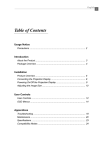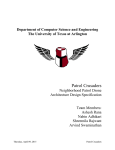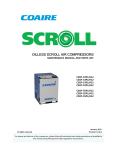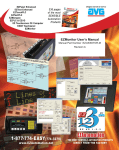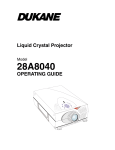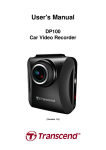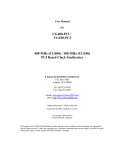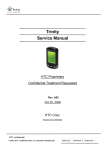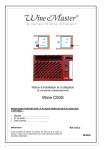Download LG LP133WH2
Transcript
LP133WH2
Liquid Crystal Display
Product Specification
SPECIFICATION
FOR
APPROVAL
(
) Preliminary Specification
(
) Final Specification
13.3” HD TFT LCD
Title
Forte
BUYER
SUPPLIER
*MODEL
MODEL
Suffix
LG Display Co., Ltd.
LP133WH2
TLA2
*When you obtain standard approval,
please use the above model name without suffix
APPROVED BY
SIGNATURE
APPROVED BY
SIGNATURE
K. J. KWON / S.Manager
/
REVIEWED BY
G. J. Han / Manager
/
PREPARED BY
/
C. Y. Kim / Engineer
S. C. Jung / Engineer
Please return 1 copy for your confirmation with
your signature and comments.
Ver. 0.0
9, Dec., 2008
Product Engineering Dept.
LG Display Co., Ltd
0/ 27
LP133WH2
Liquid Crystal Display
Product Specification
Contents
No
ITEM
Page
COVER
CONTENTS
1
RECORD OF REVISIONS
2
1
GENERAL DESCRIPTION
3
2
ABSOLUTE MAXIMUM RATINGS
4
3
ELECTRICAL SPECIFICATIONS
3-1
ELECTRICAL CHARACTREISTICS
5
3-2
INTERFACE CONNECTIONS
6
3-3
SIGNAL TIMING SPECIFICATIONS
8
3-4
SIGNAL TIMING WAVEFORMS
8
3-5
COLOR INPUT DATA REFERNECE
9
3-6
POWER SEQUENCE
10
4
OPTICAL SFECIFICATIONS
11
5
MECHANICAL CHARACTERISTICS
15
6
RELIABLITY
18
7
INTERNATIONAL STANDARDS
7-1
SAFETY
19
7-2
EMC
19
8
PACKING
8-1
DESIGNATION OF LOT MARK
20
8-2
PACKING FORM
20
PRECAUTIONS
21
APPENDIX A. Enhanced Extended Display Identification Data
23
9
A
Ver. 0.0
9, Dec., 2008
1/ 27
LP133WH2
Liquid Crystal Display
Product Specification
RECORD OF REVISIONS
Revision No Revision Date
0.0
Ver. 0.0
18. Sep. 2008
Page
-
Description
First Draft
9, Dec., 2008
EDID
ver
-
2/ 27
LP133WH2
Liquid Crystal Display
Product Specification
1. General Description
The LP133WH2 is a Color Active Matrix Liquid Crystal Display with an integral LED backlight system. The
matrix employs a-Si Thin Film Transistor as the active element. It is a transmissive type display operating in
the normally white mode. This TFT-LCD has 13.3 inches diagonally measured active display area with
WXGA resolution(1366 horizontal by 768 vertical pixel array). Each pixel is divided into Red, Green and
Blue sub-pixels or dots which are arranged in vertical stripes. Gray scale or the brightness of the sub-pixel
color is determined with a 6-bit gray scale signal for each dot, thus, presenting a palette of more than
262,144 colors.
The LP133WH2 has been designed to apply the interface method that enables low power, high speed, low
EMI.
The LP133WH2 is intended to support applications where thin thickness, low power are critical factors and
graphic displays are important. In combination with the vertical arrangement of the sub-pixels, the
LP133WH2 characteristics provide an excellent flat display for office automation products such as Notebook
PC.
-7%4
$/
(BUF%SJWFS
5JNJOH
$POUSPM
6TFS DPOOFDUPS 1JO
#MPDL
108&3
5'5-$%1BOFM
Y
-
#-0$,
0(@#UZ
4PVSDF%SJWFS$JSDVJU
QF
&%*%
#-0$,
-&%#BDLMJHIU"TT’Z
5#%-&%T 95#%TUSJOHT
$POUSPM%BUB
1PXFS
&%*%TJHOBM1PXFS
General Features
Active Screen Size
13.3 inches diagonal
Outline Dimension
306.2(Typ. H) ƒ 177.6(Typ. V) ƒ 3.5(D, Max.) mm
Pixel Pitch
Pixel Format
0.2148 ƒ 0.2148 mm
1366 horiz. by 768 vert. Pixels RGB strip arrangement
Color Depth
Luminance, White
6-bit, 262,144 colors
Power Consumption
Weight
Display Operating Mode
Logic : 0.9 W (Max.@Mosaic), Back Light : 3.5W (Max.@ ILED=TBDmA)
300g(Max.)
Transmissive mode, normally white
Surface Treatment
Hard coating(3H), Glare treatment of the front Polarizer (Haze 0%)
Ver. 0.0
220 cd/m2(Typ., @ILED=TBDmA)
9, Dec., 2008
3/ 27
LP133WH2
Liquid Crystal Display
Product Specification
2. Absolute Maximum Ratings
The following are maximum values which, if exceeded, may cause faulty operation or damage to the unit.
Table 1. ABSOLUTE MAXIMUM RATINGS
Values
Parameter
Symbol
Min
Max
Units
Notes
Power Input Voltage
VCC
-0.3
4.0
Vdc
at 25 ± 5°C
Operating Temperature
TOP
0
50
°C
1
Storage Temperature
HST
-20
60
°C
1
Operating Ambient Humidity
HOP
10
90
%RH
1
Storage Humidity
HST
10
90
%RH
1
Note : 1. Temperature and relative humidity range are shown in the figure below.
Wet bulb temperature should be 39°C Max, and no condensation of water.
90% 80%
60%
60
50
40%
40
30
20
20%
10
Hum idit y[(%)RH]
Wet Bulb
Temperature [• ]
Storage
Operation
0
10%
-20
0
10
20
30
40
50
60
70
80
Dry Bulb Temperature [• ]
Ver. 0.0
9, Dec., 2008
4/ 27
LP133WH2
Liquid Crystal Display
Product Specification
3. Electrical Specifications
3-1. Electrical Characteristics
The LP33WH2 requires two power inputs. The first logic is employed to power the LCD electronics and to
drive the TFT array and liquid crystal. The second backlight is the input about LED BL.with LED Driver.
Table 2. ELECTRICAL CHARACTERISTICS
Values
Parameter
Symbol
Min
Typ
Max
Unit
Notes
LOGIC :
Power Supply Input Voltage
VCC
3.0
3.3
3.6
V
Power Supply Input Current
Power Consumption
ICC
PCC
-
245
0.8
280
0.9
mA
W
Power Supply Inrush Current
ICC_P
-
-
TBD
mA
LVDS Impedance
ZLVDS
90
100
110
о
VLED
7
TBD
20
V
LED Power Input Current
ILED
5.0
20.0
21.0
mA
3
LED Power Comsumption
PLED
-
3.1
3.4
W
3
LED Power Inrush Current
ILED_P
-
-
TBD
mA
PWM Dimming (Duty) Ratio
-
12.5
-
100
%
PWM Impedance
ZPWM
TBD
TBD
TBD
о
PWM Frequency
FPWM
200
1
1
2
BACKLIGHT : ( with LED Driver)
LED Power Input Voltage
1500
Hz
PWM High Level Voltage
VPWM_H
2.1
3.3
5
V
PWM Low Level Voltage
VPWM_L
0
-
0.8
V
VLED_EN_H
VLED_EN_L
2.1
0
3.3
-
5
0.8
V
V
12,000
-
-
Hrs
LED_EN High Voltage
LED_EN Low Voltage
Life Time
4
5
6
Note)
1. The specified Icc current and power consumption are under the Vcc = 3.3V , 25• , fv = 60Hz condition
whereas Mosaic pattern is displayed and fv is the frame frequency.
2. This impedance value is needed to proper display and measured form
LVDS Tx to the mating connector.
3. The specified LED current and power consumption are under the Vled = 12.0V , 25• , Dimming of Max
luminance whereas White pattern is displayed and fv is the frame frequency.
4. The operation of LED Driver below minimum dimming ratio may cause flikering or relaibility issue.
5. This Spec. is not effective at 100% dimming ratio as an exception because it has DC level equivalent
to 0Hz. In spite of acceptable range as defined, the PWM Frequency should be fixed and stable for
more consistent brightness control at any specific level desired.
6. The life time is determined as the time at which brightness of LCD is 50% compare to that of minimum
value at Table 7. These LED backlight has 6 strings on it and the typical current of LED’s
string is base on Table 2.
Ver. 0.0
9, Dec., 2008
5/ 27
LP133WH2
Liquid Crystal Display
Product Specification
3-2. Interface Connections
This LCD employs two interface connections, a 40 pin connector is used for the module electronics interface
and the other connector is used for the integral backlight system.
The electronics interface connector is a model UJU 20455-040E manufactured by UJU.
Table 3. MODULE CONNECTOR PIN CONFIGURATION (CN1)
4ZNCPM
1JO
%FTDSJQUJPO
/PUFT
/$
/P$POOFDUJPO
7%%
1PXFS4VQQMZ_7
7%%
1PXFS4VQQMZ_7
7&%*%
&%*%_71PXFS
/$
3FTFSWFE#*45
$-,&%*%
&%*%$MPDL*OQVU
%"5"&%*%
&%*%%BUB*OQVU
0EE3Y*/
-7%4%JGGFSFOUJBM%BUB*/16533(
<.BUJOH$POOFDUPS>
0EE3Y*/_
_-7%4%JGGFSFOUJBM%BUB*/16533(
744
(SPVOE
20345-#40E-## series
or equivalent
0EE3Y*/
-7%4%JGGFSFOUJBM%BUB
0EE3Y*/_
_-7%4%JGGFSFOUJBM%BUB
744
(SPVOE
0EE3Y*/
-7%4%JGGFSFOUJBM%BUB
0EE3Y*/_
_-7%4%JGGFSFOUJBM%BUB*/165##)474%&
<-7%43FDFJWFS>
<$POOFDUPS>
UJU 20455-040E
<$POOFDUPSQJOBSSBOHFNFOU>
744
(SPVOE
0EE3Y$,*/
-7%4%JGGFSFOUJBM$MPDL*/165
0EE3Y$,*/_
_-7%4%JGGFSFOUJBM$MPDL*/165
744
NC
(SPVOE
No Connection
NC
No Connection
GND
Ground
NC
No Connection
NC
No Connection
GND
Ground
NC
No Connection
NC
No Connection
GND
Ground
NC
No Connection
NC
No Connection
7-&%@(/%
-&%(SPVOE
7-&%@(/%
-&%(SPVOE
7-&%@(/%
-&%(SPVOE
/$
/P$POOFDUJPO
#-*.
18.GPSMVNJOBODFDPOUSPM
#-@PO
#BDLMJHIU0O0GG$POUSPMPO7_7PGG_7
/$
3FTFSWFE
7-&%
-&%1PXFS4VQQMZ77
7-&%
-&%1PXFS4VQQMZ77
7-&%
-&%1PXFS4VQQMZ77
Ver. 0.0
9, Dec., 2008
40
1
6/ 27
LP133WH2
Liquid Crystal Display
Product Specification
3-3. LVDS Signal Timing Specifications
3-3-1. DC Specification
Symb
ol
Min
Max
Unit
Notes
LVDS Differential Voltage
|VID|
100
600
mV
-
LVDS Common mode Voltage
VCM
0.6
1.8
V
-
LVDS Input Voltage Range
VIN
0.3
2.1
V
-
Description
3-3-2. AC Specification
Description
Symbol
Min
Max
Unit
Notes
tSKEW
- 400
+ 400
ps
tSKEW
- 600
+ 600
ps
tSKEW_EO
- 1/7
+ 1/7
Tclk
-
Maximum deviation
of input clock frequency during SSC
FDEV
-
‚3
%
-
Maximum modulation frequency
of input clock during SSC
FMOD
-
200
KHz
-
85MHz > Fclk ‡
LVDS Clock to Data Skew Margin
LVDS Clock to Clock Skew Margin (Even
to Odd)
Ver. 0.0
9, Dec., 2008
65MHz
65MHz > Fclk ‡
25MHz
7/ 27
LP133WH2
Liquid Crystal Display
Product Specification
< Clock skew margin between channel >
Freq.
Fmax
'
'
DFOUFS %&7
Fcenter
Fmin
'.0%
Time
< Spread Spectrum >
3-3-3. Data Format
1) LVDS 1 Port
RCLK+
RA+/-
R3
R2
R1
R0
G0
R5
R4
R3
R2
R1
R0
G0
R5
R4
RB+/-
G4
G3
G2
G1
B1
B0
G5
G4
G3
G2
G1
B1
B0
G5
RC+/-
B5
B4
B3
B2
DE
B5
B4
B3
B2
DE
RD+/-
G7
G6
R7
R6
X
G7
G6
R7
R6
X
Previous (N-1)th Cycle
VSYNC HSYNC
B7
B6
Current (Nth ) Cycle
VSYNC HSYNC
B7
B6
Next (N+1)th Cycle
< LVDS Data Format >
Ver. 0.0
9, Dec., 2008
8/ 27
LP133WH2
Liquid Crystal Display
Product Specification
3-4. Signal Timing Specifications
This is the signal timing required at the input of the User connector. All of the interface signal timing should be
satisfied with the following specifications and specifications of LVDS Tx/Rx for its proper operation.
Table 4. TIMING TABLE
*5&.
4ZNCPM
DCLK
Hsync
.J
6OJU
72.3
-
U)1
TBD
1526
TBD
U8)
TBD
32
TBD
TBD
1366
TBD
G
Period
Width
$-,
UX)"
U71
TBD
790
TBD
Width
U87
TBD
5
TBD
TBD
768
TBD
UX7"
/PUF
.)[
Period
Width-Active
Data
Enable
.BY
-
Frequency
Width-Active
Vsync
O
5ZQ
Horizontal back porch
UHBP
TBD
80
TBD
Horizontal front porch
U
TBD
48
TBD
U
TBD
14
TBD
U7'1
TBD
3
TBD
U$-,
U)1
U$-,
)'1
Vertical back porch
7#1
Vertical front porch
3-5. Signal Timing Waveforms
U)1
Condition : V =3.3V
CC
High: 0.7VCC
Low: 0.3VCC
tHP
Hsync tWH
tHBP
tWHA
tHFP
tWVA
tVFP
Date Enable
tVP
tWV
Vsync
tVBP
Date Enable
Ver. 0.0
9, Dec., 2008
9/ 27
LP133WH2
Liquid Crystal Display
Product Specification
3-6. Color Input Data Reference
The brightness of each primary color (red,green and blue) is based on the 6-bit gray scale data input for the
color ; the higher the binary input, the brighter the color. The table below provides a reference for color
versus data input.
Table 5. COLOR DATA REFERENCE
Input Color Data
RED
Color
GREEN
MSB
R5
Black
Red
Green
Basic
Blue
Color
Cyan
Magenta
Yellow
White
RED (00)
RED (01)
RED
GREEN
BLUE
Ver. 0.0
BLUE
LSB
R4
R3
R2
R1
MSB
MSB
R0
LSB
LSB
G4 G3
G5
G2
G1
G0
5
B4
B3
B2
B1
0
0
0
0
0
0 0
0
0
0
0
0 0
0
0
0
0
0
1
1
1
1
1
1 0
0
0
0
0
0 0
0
0
0
0
0
0
0
0
0
0
0 1
1
1
1
1
1 0
0
0
0
0
0
0
0
0
0
0
0 0
0
0
0
0
0 1
1
1
1
1
1
0
0
0
0
0
0 1
1
1
1
1
1 1
1
1
1
1
1
1
1
1
1
1
1 0
0
0
0
0
0 1
1
1
1
1
1
1
1
1
1
1
1 1
1
1
1
1
1 0
0
0
0
0
0
1
1
1
1
1
1 1
1
1
1
1
1 1
1
1
1
1
1
0
0
0
0
0
0 0
0
0
0
0
0 0
0
0
0
0
0
0
0
0
0
0
1 0
0
0
0
0
0 0
0
0
0
0
0
…
B0
…
…
…
RED (62)
1
1
1
1
1
0 0
0
0
0
0
0 0
0
0
0
0
0
RED (63)
1
1
1
1
1
1 0
0
0
0
0
0 0
0
0
0
0
0
GREEN (00)
0
0
0
0
0
0 0
0
0
0
0
0 0
0
0
0
0
0
GREEN (01)
0
0
0
0
...
0
0
0
0
0
0
…
0
1
0
0
0
0
…
0
0
…
GREEN (62)
0
0
0
0
0
0 1
1
1
1
1
0 0
0
0
0
0
0
GREEN (63)
0
0
0
0
0
0 1
1
1
1
1
1 0
0
0
0
0
0
BLUE (00)
0
0
0
0
0
0
0
0
0
0
0
0
0
0
0
0
0
0
BLUE (01)
0
0
0
0
0
0
0
0
0
0
0
0
0
0
0
0
0
1
…
…
…
…
BLUE (62)
0
0
0
0
0
0 0
0
0
0
0
0 1
1
1
1
1
0
BLUE (63)
0
0
0
0
0
0 0
0
0
0
0
0 1
1
1
1
1
1
9, Dec., 2008
10/ 27
B
LP133WH2
Liquid Crystal Display
Product Specification
3-7. Power Sequence
90%
90%
Power Supply Input
VCC
10%
0V 10%
T1T2
Interface Signal, Vi
LVDS
T5 T6
Valid Data
T7
0V
T4
T3
LED input Voltage
VLED
T11
T8
0V
Valid Data
Dimming control signal
Of LED BL
PWM
0V (Low)
T9
LED on/off control Signal
LED_EN
T10
0V (Off)
Table 6. POWER SEQUENCE TABLE
Value
Parameter
Units
Min.
Typ.
Max.
T1
0.5
-
10
ms
T
2
0
-
50
ms
T
3
200
-
-
ms
T
4
200
-
-
ms
T
5
0
-
50
ms
T
6
3
-
10
ms
T
7
400
-
-
ms
T
8
50
-
100
ms
T
9
0
-
100
ms
0
-
100
ms
50
-
100
ms
T10
T
Note)
1. Valid Data is Data to meet “3-3. LVDS Signal Timing Specifications”
2. Please avoid floating state of interface signal at invalid period.
3. When the interface signal is invalid, be sure to pull down the power supply for LCD VCC to 0V.
4. LED power must be turn on after power supply for LCD and interface signal are valid.
Ver. 0.0
11
9, Dec., 2008
11/ 27
LP133WH2
Liquid Crystal Display
Product Specification
4. Optical Specification
Optical characteristics are determined after the unit has been ‘ON’ and stable for approximately 20 minutes in
a dark environment at 25°C. The values specified are at an approximate distance 50cm from the LCD surface
at a viewing angle of Φ and Θ equal to 0°.
FIG. 1 presents additional information concerning the measurement equipment and method.
FIG. 1 Optical Characteristic Measurement Equipment and Method
Optical Stage(x,y)
LCD Module
Equipment
500mm‚ 50mm
Table 7. OPTICAL CHARACTERISTICS
Parameter
Contrast Ratio
Response Time
Values
Symbol
Units
Min
300
CR
Surface Luminance, white
Luminance Variation
Ta=25°C, VCC=3.3V, fV=60Hz, fCLK= 97.75MHz, ILED =TBD mA
Typ
500
Max
-
1
190
220
1.4
1.6
cd/m
-
16
25
ms
RX
TBD
TBD
TBD
RY
TBD
TBD
TBD
GX
TBD
TBD
TBD
GY
TBD
TBD
TBD
TBD
TBD
LWH
δ WHITE
5S 3
_
5S
%
Notes
2
2
3
4
Color Coordinates
RED
GREEN
BLUE
TBD
TBD
TBD
WX
0.283
0.313
0.343
WY
0.299
0.329
0.359
x axis, right(Φ=0°)
Θr
40
degree
x axis, left (Φ=180°)
y axis, up (Φ=90°)
Θl
Θu
40
degree
y axis, down (Φ=270°)
Θd
10
30
degree
degree
WHITE
BX
BY
TBD
Viewing Angle
5
6
Gray Scale
Ver. 0.0
9, Dec., 2008
12/ 27
LP133WH2
Liquid Crystal Display
Product Specification
Note)
1. Contrast Ratio(CR) is defined mathematically as
Surface Luminance with all white pixels
Contrast Ratio =
Surface Luminance with all black pixels
2. Surface luminance is the average of 5 point across the LCD surface 50cm from the surface with
all pixels displaying white. For more information see FIG 1.
LWH= Average(L1,L2, … L5)
3. The variation in surface luminance , The panel total variation (δ WHITE) is determined by measuring LN
at each test position 1 through 13 and then defined as followed numerical formula.
For more information see FIG 2.
Maximum(L1,L2, … L13)
δ WHITE
=
Minimum(L1,L2, … L13)
4. Response time is the time required for the display to transition from white to black (rise time, TrR) and
from black to white(Decay Time, TrD). For additional information see FIG 3.
5. Viewing angle is the angle at which the contrast ratio is greater than 10. The angles are determined
for the horizontal or x axis and the vertical or y axis with respect to the z axis which is normal to the
LCD surface. For more information see FIG 4.
6. Gray scale specification
* fV= 60Hz
Luminance [%] (Typ)
Gray Level
L0
L7
5#%
L15
L23
5#%
L31
L39
5#%
L47
L55
5#%
5#%
5#%
5#%
L63
Ver. 0.0
9, Dec., 2008
13/ 27
LP133WH2
Liquid Crystal Display
Product Specification
FIG. 2 Luminance
<Measuring point for Average Luminance & measuring point for Luminance variation>
H
C
A
L6
D
L8
L7
H,V : ACTIVE AREA
A : H/4 mm
B : V/4 mm
C : 10 mm
D : 10 mm
POINTS : 13 POINTS
L3
V
B
L2
L1
L9
L10
Center Point
L4
L5
L12
L11
L13
FIG. 3 Response Time
The response time is defined as the following figure and shall be measured by switching the input signal
for “black” and “white”.
TrD
TrR
%
100
90
Optical
Response
10
0
white
white
black
FIG. 4 Viewing angle
Normal
Eye
<Dimension of viewing angle range>
φ = 180°
,
Left
Y
φ = 90°, Up
θ
φ
,
φ = 0°
Right
,
φ = 270°
Down
Ver. 0.0
9, Dec., 2008
14/ 27
LP133WH2
Liquid Crystal Display
Product Specification
5. Mechanical Characteristics
The contents provide general mechanical characteristics for the model LP133WH2.
In addition the figures in the next page are detailed mechanical drawing of the LCD.
Outline Dimension
Horizontal
306.2 ± 0.50mm
Vertical
177.6 ± 0.50mm
Depth
3.5mm(Max.)
Horizontal
296.62 mm
Vertical
168.17 mm
Horizontal
293.42mm
Vertical
164.97 mm
Bezel Area
Active Display Area
Weight
Surface Treatment
Ver. 0.0
300g(Max.)
Hard coating(3H), Glare treatment of the front Polarizer (Haze 0%)
9, Dec., 2008
15/ 27
LP133WH2
Liquid Crystal Display
Product Specification
<FRONT VIEW>
Ver. 0.0
Note) Unit:[mm], General tolerance: ± 0.5mm
9, Dec., 2008
16/ 27
LP133WH2
Liquid Crystal Display
Product Specification
<REAR VIEW>
Ver. 0.0
Note) Unit:[mm], General tolerance: ± 0.5mm
9, Dec., 2008
17/ 27
LP133WH2
Liquid Crystal Display
Product Specification
6. Reliability
Environment test condition
No.
Conditions
Test Item
1
High temperature storage test
Ta= 60°C, 240h
2
Low temperature storage test
Ta= -20°C, 240h
3
High temperature operation test
Ta= 50°C, 50%RH, 240h
4
Low temperature operation test
Ta= 0°C, 240h
5
Vibration test (non-operating)
Sine wave, 5 ~ 150Hz, 1.5G, 0.37oct/min
3 axis, 30min/axis
6
Shock test (non-operating)
- No functional or cosmetic defects following a shock
to all 6 sides delivering at least 180 G in a half sine
pulse no longer than 2 ms to the display module
- No functional defects following a shock delivering
at least 200 g in a half sine pulse no longer than 2
ms to each of 6 sides. Each of the 6 sides will be
shock tested with one each display, for a total of 6
displays
7
Altitude
0 ~ 10,000 feet (3,048m) 24Hr
0 ~ 40,000 feet (12,192m) 24Hr
operating
storage / shipment
{ Result Evaluation Criteria }
There should be no change which might affect the practical display function when the display quality
test is conducted under normal operating condition.
Ver. 0.0
9, Dec., 2008
18/ 27
LP133WH2
Liquid Crystal Display
Product Specification
7. International Standards
7-1. Safety
a) UL 60950-1:2003, First Edition, Underwriters Laboratories, Inc.,
Standard for Safety of Information Technology Equipment.
7-2. EMC
a) ANSI C63.4 “Methods of Measurement of Radio-Noise Emissions from Low-Voltage Electrical and
Electrical Equipment in the Range of 9kHZ to 40GHz. “American National Standards Institute(ANSI),
1992
b) CISPR22 “Limits and Methods of Measurement of Radio Interface Characteristics of Information
Technology Equipment.“ International Special Committee on Radio Interference.
c) EN 55022 “Limits and Methods of Measurement of Radio Interface Characteristics of Information
Technology Equipment.“ European Committee for Electrotechnical Standardization.(CENELEC), 1998
( Including A1: 2000 )
Ver. 0.0
9, Dec., 2008
19/ 27
LP133WH2
Liquid Crystal Display
Product Specification
8. Packing
8-1. Designation of Lot Mark
a) Lot Mark
A
B
C
D
E
F
G
H
A,B,C : SIZE(INCH)
E : MONTH
I
J
K
L
M
D : YEAR
F ~ M : SERIAL NO.
Note
1. YEAR
Year
2001
2002
2003
2004
2005
2006
2007
2008
2009
2010
Mark
1
2
3
4
5
6
7
8
9
0
Month
Jan
Feb
Mar
Apr
May
Jun
Jul
Aug
Sep
Oct
Nov
Dec
Mark
1
2
3
4
5
6
7
8
9
A
B
C
2. MONTH
b) Location of Lot Mark
Serial No. is printed on the label. The label is attached to the backside of the LCD module.
This is subject to change without prior notice.
8-2. Packing Form
a) Package quantity in one box : TBD pcs
b) Box Size : TBD
Ver. 0.0
9, Dec., 2008
20/ 27
LP133WH2
Liquid Crystal Display
Product Specification
9. PRECAUTIONS
Please pay attention to the followings when you use this TFT LCD module.
9-1. MOUNTING PRECAUTIONS
(1) You must mount a module using holes arranged in four corners or four sides.
(2) You should consider the mounting structure so that uneven force (ex. Twisted stress) is not applied to the
module. And the case on which a module is mounted should have sufficient strength so that external
force is not transmitted directly to the module.
(3) Please attach the surface transparent protective plate to the surface in order to protect the polarizer.
Transparent protective plate should have sufficient strength in order to the resist external force.
(4) You should adopt radiation structure to satisfy the temperature specification.
(5) Acetic acid type and chlorine type materials for the cover case are not desirable because the former
generates corrosive gas of attacking the polarizer at high temperature and the latter causes circuit break
by electro-chemical reaction.
(6) Do not touch, push or rub the exposed polarizers with glass, tweezers or anything harder than HB
pencil lead. And please do not rub with dust clothes with chemical treatment.
Do not touch the surface of polarizer for bare hand or greasy cloth.(Some cosmetics are detrimental
to the polarizer.)
(7) When the surface becomes dusty, please wipe gently with absorbent cotton or other soft materials like
chamois soaks with petroleum benzene. Normal-hexane is recommended for cleaning the adhesives
used to attach front / rear polarizers. Do not use acetone, toluene and alcohol because they cause
chemical damage to the polarizer.
(8) Wipe off saliva or water drops as soon as possible. Their long time contact with polarizer causes
deformations and color fading.
(9) Do not open the case because inside circuits do not have sufficient strength.
9-2. OPERATING PRECAUTIONS
(1) The spike noise causes the mis-operation of circuits. It should be lower than following voltage :
V=‚ 200mV(Over and under shoot voltage)
(2) Response time depends on the temperature.(In lower temperature, it becomes longer.)
(3) Brightness depends on the temperature. (In lower temperature, it becomes lower.)
And in lower temperature, response time(required time that brightness is stable after turned on) becomes
longer.
(4) Be careful for condensation at sudden temperature change. Condensation makes damage to polarizer or
electrical contacted parts. And after fading condensation, smear or spot will occur.
(5) When fixed patterns are displayed for a long time, remnant image is likely to occur.
(6) Module has high frequency circuits. Sufficient suppression to the electromagnetic interference shall be
done by system manufacturers. Grounding and shielding methods may be important to minimized the
interference.
Ver. 0.0
9, Dec., 2008
21/ 27
LP133WH2
Liquid Crystal Display
Product Specification
9-3. ELECTROSTATIC DISCHARGE CONTROL
Since a module is composed of electronic circuits, it is not strong to electrostatic discharge. Make certain that
treatment persons are connected to ground through wrist band etc. And don’t touch interface pin directly.
9-4. PRECAUTIONS FOR STRONG LIGHT EXPOSURE
Strong light exposure causes degradation of polarizer and color filter.
9-5. STORAGE
When storing modules as spares for a long time, the following precautions are necessary.
(1) Store them in a dark place. Do not expose the module to sunlight or fluorescent light. Keep the
temperature between 5°C and 35°C at normal humidity.
(2) The polarizer surface should not come in contact with any other object.
It is recommended that they be stored in the container in which they were shipped.
9-6. HANDLING PRECAUTIONS FOR PROTECTION FILM
(1) When the protection film is peeled off, static electricity is generated between the film and polarizer.
This should be peeled off slowly and carefully by people who are electrically grounded and with well
ion-blown equipment or in such a condition, etc.
(2) The protection film is attached to the polarizer with a small amount of glue. If some stress is applied
to rub the protection film against the polarizer during the time you peel off the film, the glue is apt to
remain on the polarizer.
Please carefully peel off the protection film without rubbing it against the polarizer.
(3) When the module with protection film attached is stored for a long time, sometimes there remains a
very small amount of glue still on the polarizer after the protection film is peeled off.
(4) You can remove the glue easily. When the glue remains on the polarizer surface or its vestige is
recognized, please wipe them off with absorbent cotton waste or other soft material like chamois
soaked with normal-hexane.
Ver. 0.0
9, Dec., 2008
22/ 27
LP133WH2
Liquid Crystal Display
Product Specification
APPENDIX A. Enhanced Extended Display Identification Data (EEDIDTM)
1/3
TBD
Ver. 0.0
9, Dec., 2008
23/ 27
LP133WH2
Liquid Crystal Display
Product Specification
APPENDIX A. Enhanced Extended Display Identification Data (EEDIDTM)
2/3
TBD
Ver. 0.0
9, Dec., 2008
24/ 27
LP133WH2
Liquid Crystal Display
Product Specification
APPENDIX A. Enhanced Extended Display Identification Data (EEDIDTM)
3/3
TBD
Ver. 0.0
9, Dec., 2008
25/ 27


























